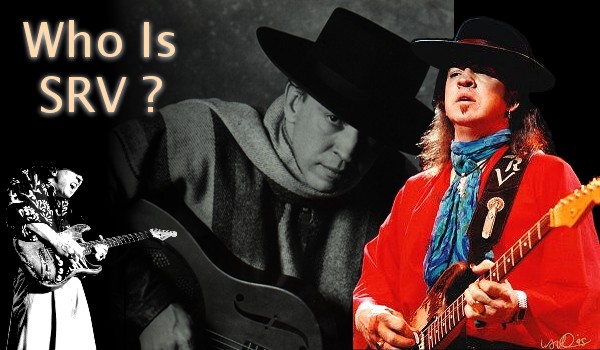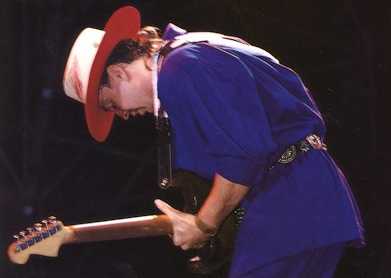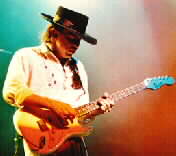

Stevie Ray Vaughan was an
electric blues/rock guitarist. He began his recording career in 1983 and after 7 short years he had conquered the music world, winning 3 Grammy Awards, and had succeeded in conquering his greatest foe, substance abuse.
Though Stevie's genre of choice was blues,
In 1990, at the paramount of his career, Stevie was tragically killed in a helicopter accident.
The list of those who have paid him tribute reads like the who's who of the music world. Among them are Stevie Wonder, Eric Clapton, David Bowie, Mick Jagger and the Stones, Bonnie Raitt, Buddy Guy, Robert Cray, John Lee Hooker, Gregg Allman, B.B. King, Albert King, Steve Winwood, Jackson Brown,
Stevie Ray Vaughan received two more Grammy Awards for his work on the posthumously released CD, Family Style, and one more for Best Album on The Sky Is Crying (for a total of 6 Grammy Awards). If you've never heard him play the guitar, then you've never heard it done right.
With his astonishingly accomplished guitar playing, Stevie Ray Vaughan ignited the blues revival of the '80s. Vaughan drew equally from bluesmen like Albert King, Otis Rush, and Muddy Waters and rock & roll players like Jimi Hendrix and Lonnie Mack, as well as the stray jazz guitarist like Kenny Burrell, developing a uniquely eclectic and fiery style that sounded like no other guitarist, regardless of genre. Vaughan bridged the gap between blues and rock like no other artist had since the late '60s. For the next seven years, Stevie Ray was the leading light in American blues, consistently selling out concerts while his albums regularly went gold. His tragic death in 1990 only emphasized his influence in blues and American rock & roll.
Born and raised in Dallas, Stevie Ray Vaughan began playing guitar as a child, inspired by older brother Jimmie. When he was in junior high school, he began playing in a number of garage bands, which occasionally landed gigs in local nightclubs. By the time he was 17, he had dropped out of high school to concentrate on playing music. Vaughan's first real band was the Cobras, who played clubs and bars in Austin during the mid-'70s. Following that group's demise, he formed Triple Threat in 1975. Triple Threat also featured bassist Jackie Newhouse, drummer Chris Layton, and vocalist Lou Ann Barton and W.C. Clark. After a few years of playing Texas bars and clubs, Barton left the band in 1978. The group decided to continue performing under the name Double Trouble, which was inspired by the Otis Rush song of the same name; Stevie Ray became the band's lead singer.
For the next few years, Stevie Ray Vaughan and Double Trouble played the Austin area, becoming one of the most popular bands in Texas. In 1982, the band played the Montreux Festival and their performance caught the attention of David Bowie and Jackson Browne. After Double Trouble's performance, Bowie asked Vaughan to play on his forthcoming album, while Browne offered the group free recording time at his Los Angeles studio, Downtown; both offers were accepted. Stevie Ray laid down the lead guitar tracks for what became Bowie's Let's Dance album in late 1982. Shortly afterward, John Hammond, Sr. landed Vaughan and Double Trouble a record contract with Epic and the band recorded their debut album in less than a week at Downtown.
Vaughan's debut album, Texas Flood, was released in the summer of 1983, a few months after Bowie's Let's Dance appeared. On its own, Let's Dance earned Vaughan quite a bit of attention, but Texas Flood was a blockbuster blues success, receiving positive reviews in both blues and rock publications, reaching number 38 on the charts, and crossing over to album rock radio stations. Bowie offered Vaughan the lead guitarist role for his 1983 stadium tour, but Stevie Ray turned him down, preferring to play with Double Trouble. Stevie Ray and Double Trouble set off on a successful tour and quickly recorded their second album, Couldn't Stand the Weather, which was released in May of 1984. The album was more successful than its predecessor, reaching number 31 on the charts; by the end of 1985, the album went gold. Double Trouble added keyboardist Reese Wynans in 1985, before they recorded their third album, Soul To Soul. The record was released in August, 1985 and was also quite successful, reaching number 34 on the charts.
Although his professional career was soaring, Vaughan was sinking deep into alcoholism and drug addiction. Despite his declining health, Stevie Ray continued to push himself, releasing the double live album Live Alive in October of 1986. Stevie checked into the Charter facility in Atlanta, on Oct. 13, 1986.
The guitarist's time in rehab was kept fairly quiet and for the next year, Stevie Ray and Double Trouble were less active. Vaughan performed a number of concerts in 1988, including a headlining gig at the New Orleans Jazz & Heritage Festival, and wrote his fourth album. The resulting record, In Step, appeared in June of 1989 and became his most successful album, peaking at number 33 on the charts, earning a Grammy for Best Contemporary Blues Recording, and going gold just over six months after its release.
In the spring of 1990, Stevie Ray recorded an album with his brother Jimmie, which was scheduled for release in the fall of the year. In the late summer of 1990, Vaughan and Double Trouble set out on an American headlining tour. On August 26, 1990, their East Troy, WI gig concluded with an encore jam featuring guitaritsts Eric Clapton, Buddy Guy, Jimmie Vaughan, and Robert Cray. After the concert, Stevie Ray Vaughan boarded a helicopter bound for Chicago. Minutes after its 12:30 AM takeoff, the helicopter crashed, killing Vaughan and the other four passengers. Vaughan was only 35 years old.
Family Style, Stevie Ray's duet album with Jimmie Vaughan, appeared in October and entered the charts at number seven. Family Style began a series of posthumous releases that were as popular as the albums Stevie Ray released during his lifetime. The Sky is Crying, a collection of studio outtakes compiled by Jimmie Vaughan, was released in October of 1991; it entered the charts at number ten and went platinum three months after its release. In the Beginning, a recording of a Double Trouble concert in 1980, was released in the fall of 1992 and the compilation Greatest Hits was released in 1995. In 1999, Vaughan's original albums were remastered and reissued, with The Real Deal: Greatest Hits Vol. 2 also appearing that year. 2000 saw the release of the four-disc box SRV, which concentrated heavily on outtakes, live performances, and rarities.
Stephen Thomas Erlewine (with some changes)
 he could play anything. In an all-too-short career, he had proven to many that he was not only the greatest electric guitarist alive, but of all times.
he could play anything. In an all-too-short career, he had proven to many that he was not only the greatest electric guitarist alive, but of all times.
 The Neville Brothers, Joe Satriani, Steve Vai, Lonnie Mack, Albert Collins, W.C. Clark, newcomers Kenny Wayne Shepherd and Johnny Lang, and countless others including Stevie's older brother Jimmie.
The Neville Brothers, Joe Satriani, Steve Vai, Lonnie Mack, Albert Collins, W.C. Clark, newcomers Kenny Wayne Shepherd and Johnny Lang, and countless others including Stevie's older brother Jimmie.